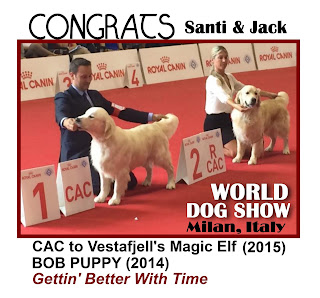That lovable Golden Retriever cuddled up beside you on the couch could very well have been called-- in fact, early on was called --a Yellow Retriever. His name evolved over time. In fact, he might also have been called a Russian Retriever.
Myths have great staying power, after all. Despite the breeding records of Lord Tweedmouth to the contrary, there was a long-held belief (referenced and held in Great Britain as late as the mid-nineteen fifties) that our breed was developed from a troupe of white circus dogs brought to that nation. There is absolutely no concrete evidence suggesting that that ever happened. But the renowned Mrs. Charlesworth-- a towering force in the development of the breed-- went to her death holding strictly to that source of origin. She would not be moved or convinced by any factual evidence to the contrary. She believed what she believed; end of story. And she was hardly alone in her opinion. Other leading spokesmen in her breed echoed her sentiments.
So the name Yellow Retriever is now the stuff of history. And the name Russian Retriever never caught on. In fact you would be hard pressed to find such a name referenced anywhere in breed history. It was a suggestion offered, but rejected.
Thus, we have the Golden Retriever. It was a name chosen not because all dogs that fit the breed description were gold in color. There were many which were red enough to be confused with the red setters of the time. Not surprising, one supposes, since that breed was used early on in its development. In fact, the embarrassment caused by this occasional mistaken identity caused the earliest fanciers of the breed to summarily reject red or mahogany as a legitimate coat color. Thus it remains today-- no nation's breed standard allows the red-coated Golden a place in the conformation ring.
But what of the yellow Goldens? Some observers insisted that they be included in the standard, since the first dogs recognized as a distinct breed were a yellow to cream in color. Charlesworth herself felt that their exclusion was unwarranted, but she later remarked that she had been outvoted when the first breed standard was developed. It took relatively little time to fix things, however. A revised breed standard declared that both gold and cream were acceptable coat colors.
But Americans begged to differ. When the standard for the breed was adopted by the AKC and later on by the Golden Retriever Club of America it rejected the amended British standard and declared that coat color could be gold only; never red and if cream, subject to penalty and viewed as undesirable. The word cream was not used; rather overly pale or light- colored dogs were singled out by the breed standard.
From that point on, the American mantra was "to be truly a Golden Retriever, a Golden Retriever must be gold in color." The reds and creams looked for all intents and purposes to be truly Golden Retrievers in structure, but were to be avoided for show or breeding purposes. No one denied that. But the full range of birth colors was limited-- at both ends of the color spectrum. Acceptability was based upon what I call the "Goldilocks" standard. Not too much, not too little, but just enough gold to qualify as a Golden Retriever.
How was this justified? Simply by the name he was given. How can a Golden Retriever be anything other than gold in color-- even if they are? The name conferred is all the "proof" required.
Facts be damned. There is no such thing as a gold master gene for dogs-- in any breed. All are based upon either the black master gene (or brown by extension) or the red master gene. Geneticists have identified a red/yellow spectrum in the dog world. But they have yet to distinguish between the red and the yellow. Similarly, they have posited genetic factors which cause dogs to have various levels of intensity within the red color range. But these alleles have yet to be isolated. They also are quite certain that specific genetic factors cause the darkening of coats in our breed over time. Not yet isolated. And finally, that the dilute alleles producing our cream-coated Goldens have yet to be discovered though they most certainly exist in the breed. In time, they will be identified and a Golden Retriever's complete genetic makeup will be ascertainable at last.
What all this means is that the genetic makeup of a gold Golden Retriever is different from a red Golden Retriever and is other than that of the cream Golden Retriever. Logically, a born cream Golden cannot later become a gold Golden. That is a genetic impossibility. Nor can a born red Golden somehow turn into a gold Golden at maturity.
Again, facts be damned. The AKC/GRCA standard insists that all Golden Retrievers are born, mature, and die some shade of gold (even while that standard insists that red Goldens are just too dark gold and cream coats are too pale gold in color). Aesthetics triumphs over reason and factual evidence.The leading spokesmen (more precisely, spokeswomen) for our breed in America even go so far as to reinterpret the British standard to suit their own purposes. To them, cream in that country-of-origin standard refers to markings or shadings found on an otherwise gold dog.
.It has been said that history is the fable most often repeated. In the case of the Golden Retriever in America, the tellers of fables have won the battle...for now. Fiction rules over fact. Their entire argument with regard to coat color is a house of cards, destined to collapse over time. Meanwhile, the future of the breed continues to suffer from a lack of genetic diversity due to parallel breeding programs maintained by those who support either the American type or European (English) type Golden Retriever. True. there is some degree of cross breeding between the two types, but far less than one might hope for, considering the problems unique to our breed or otherwise. And the great dividing line remains: coat color. Ridiculous but true.
Tuesday, April 5, 2016
Friday, June 12, 2015
Wednesday, May 13, 2015
Solid Gold
This is why we breed our Goldens. A great example. Can it get any better than this? The dog pictured is Tramin Arni Joy, a consistent winner on the European show circuit.
Thursday, April 23, 2015
Gold Stars and a Lowlife Who Tars....
In the highly competitive dog BUSINESS there are rewards to be had, and those who are bad...for the breed, and not much good for anything else. It is difficult to know who-- if anyone --to trust. Who you wish to recommend to others. This, my friends, is sad but true. Some breeders have outstanding reputations, and deservedly so. Others are pathetic to the core. In time, you will hopefully discover this for yourselves.
There is a sucker born every minute-- be an intelligent buyer
P.T. Barnum was quoted as saying, "There's a sucker born every minute." Apparently, the comment was first voiced by David Hannum, who was involved in a legal dispute with Barnum involving hoaxes connected to so-called giants buried in the earth. But today we attribute the quote to P.T. regardless of origin.
Some breeders are charging obscene prices for their Golden pups. No breed club can do anything about it. Nor can the AKC. What we can do is educate the public about these ripoffs when they occur. Ultimately, though, it is up to the puppy buyer to do his homework.
Years ago, when I was involved with another breed, a potential buyer rejected my pup because I was CHARGING TOO LITTLE. Clearly, the pup must be inferior at that price. Comparing pedigrees I showed him how similar the backgrounds were of ALL Bearded Collies in the U.S. at the time. He was unconvinced and purchased a pup elsewhere for more than four times the cost of mine. Perhaps that gave him bragging rights. Who knows. In any event, both the sire and dam of my litter were AKC show champions. Apparently that was not enough for the gentleman. His loss, not mine.
Some breeders are charging obscene prices for their Golden pups. No breed club can do anything about it. Nor can the AKC. What we can do is educate the public about these ripoffs when they occur. Ultimately, though, it is up to the puppy buyer to do his homework.
Years ago, when I was involved with another breed, a potential buyer rejected my pup because I was CHARGING TOO LITTLE. Clearly, the pup must be inferior at that price. Comparing pedigrees I showed him how similar the backgrounds were of ALL Bearded Collies in the U.S. at the time. He was unconvinced and purchased a pup elsewhere for more than four times the cost of mine. Perhaps that gave him bragging rights. Who knows. In any event, both the sire and dam of my litter were AKC show champions. Apparently that was not enough for the gentleman. His loss, not mine.
Monday, April 20, 2015
June Is Just Around the Corner...sort of....
Just a gentle reminder to make plans to attend what should be a fun-filled and informative event. The judges are outstanding; the competition should be excellent, with multiple chances to win. It's part of a six-show IABCA weekend, so you may very well have the opportunity to earn both puppy and adult championships in a single weekend. If a typical event, there will be lots of owner/handlers in the ring-- that alone will level the competition considerably. And the AKC/GRCA breed standard will NOT be used to evaluate the entries. So coat color will NOT be an issue for the judges in any way whatever.
Subscribe to:
Comments (Atom)







